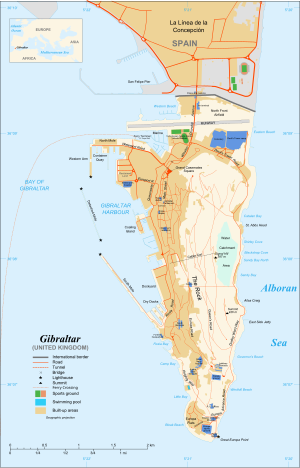Inundation, Gibraltar
| Inundation | |
|---|---|
| La Laguna | |
| Part of Fortifications of Gibraltar | |
| Gibraltar | |

View over the Neutral Ground and Inundation from British positions on the Rock of Gibraltar, depicted in 1828
|
|
| Coordinates | 36°08′50″N 5°20′57″W / 36.147258°N 5.349093°W |
| Type | Body of water |
| Site information | |
| Owner | Government of Gibraltar |
| Open to the public |
Yes |
| Condition | Drained and reclaimed |
| Site history | |
| Built | 1735 |
| Demolished | Post World War II |
The Inundation was a flooded and fortified area of ground on the sandy isthmus between Spain and Gibraltar, created by the British in the 18th century to restrict access to the territory as part of the fortifications of Gibraltar. It was originally a marshy area known as the Morass at the far south-western end of the isthmus, occupying the area adjacent to the north-western flank of the Rock of Gibraltar. The Morass was dug out and expanded to create an artificial lake which was further obstructed by iron and wooden obstacles in the water. Two small fortifications on either side controlled access to Gibraltar. The only road to and from the town ran along a narrow causeway between the Inundation and the sea which was enfiladed by batteries mounted on the lower slopes of the Rock. The Inundation existed for about 200 years before it was infilled and built over after the Second World War.
Prior to the creation of the Inundation, the principal access to Gibraltar was via a narrow strip of land between the Morass and the cliff face of the Rock. During the Thirteenth Siege of Gibraltar, the Spanish had managed to dig trenches along this strip of land to reach within only 600 feet (180 m) of the walls of Gibraltar. A redan or flèche was built in front of the town's Landport Gate during the siege to overlook the Morass and provide additional defence.
Oliver Cromwell had suggested in the previous century that a canal could be dug across the isthmus to make Gibraltar an island. Although this idea was not taken up, British commanders decided to make the Morass a more substantial obstacle and in 1735, it was dug out and flooded to form a pear-shaped lake connected to the sea via a short channel. The water in the Inundation was originally held back by a 4 ft (1.2 m) high dike, which allowed the 5 ft (1.5 m) high tide to replenish it, though this arrangement was changed in the 19th century. The Inundation restricted landward access to Gibraltar to two narrow passages on either side of the water, one immediately below the sheer cliff face of the Rock and the other, which was used as the main road into Gibraltar (now Winston Churchill Avenue), forming a narrow causeway known as the Strand between the sea and the Landport Gate. According to a late 18th-century author, the Inundation measured about 200 yards (180 m) in length by about 60 yards (55 m) broad and was "nearly man-height" in depth.
...
Wikipedia

